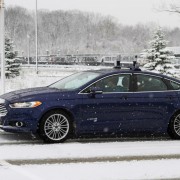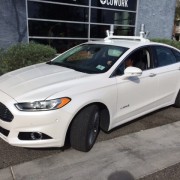News Roundup: Ford Teases All-New Hybrid-Electric Self-Driving Car, Ouster Puts Its Autonomous Drive Sensor Up For Sale Online, and More
Jennifer van der Kleut
Ford teases all-new hybrid-electric car designed specifically as a self-driving model
Ford Motors’s executive vice-president of global products, Jim Farley, gave a small sneak-peek this week as to the company’s plans for a self-driving car. In a blog post posted on Medium, Farley said the company has been hard at work behind the scenes designing an entirely new hybrid-electric model to serve as the company’s flagship driverless car. Farley says it will be suited for commercial deployment in both ride-hailing and delivery fleets. Ford representatives plan to start testing these vehicles in 2018, and said they are currently on track for commercial deployment in 2021. The cars will reportedly be manufactured at the company’s Flat Rock Assembly Plant in southeastern Michigan. Read more from Car and Driver.
Ouster: Our self-driving Lidar sensor is better, cheaper, and you can buy it now
It’s no secret that there is intense competition in the driverless transportation industry for the software, hardware and sensors that allow vehicles to navigate without needing human drivers. One startup, Ouster, is making waves this week by announcing to the world that their Lidar sensor is better than anything else currently on the market, is less expensive, and, most notably, it’s available for purchase now. The San Francisco-based firm has put its spinning, 64-laser OS1 Lidar sensor up for sale on its website at a price of $12,000. What’s more, the startup said it has raised $27 million from investors like Ford Motors’s Bill Ford and Cox Enterprises to boost production in anticipation of orders. In comparison, one of the most popular sensors on the market today, Velodyne’s HDL-64 sells for $75,000, and Ouster says its sensor is lighter, smaller and more efficient. Some compare the size of Velodyne’s sensor to a bucket of Kentucky Fried Chicken, whereas Ouster’s sensor is half the size of a standard coffee mug. Read more about Ouster and its sensor from Forbes.
Apple exec shows off self-driving technology to large group of researchers
The usually secretive Apple gave a rare glimpse into its work on machine learning last week when the company’s director of artificial intelligence, Ruslan Salakhutdinov, entertained a large group of AI researchers during a conference. Salakhutdinov demonstrated how Apple uses machine learning as a technique for analyzing large stockpiles of data, and how it can be beneficial to self-driving vehicles. VoxelNet, Apple’s machine learning project that pertains to self-driving cars, can reportedly detect obstacles such as pedestrians and cyclists efficiently using 3D scans taken by lidar sensors, as well as cameras that can effectively track a car’s location in real-time. Salakhutdinov demonstrated how the VoxelNet software can detect pedestrians even when they are partially hidden behind parked cars, and during inclement weather when raindrops fell on the sensors. Read more from WIRED.
Image: Ouster sensor on a self-driving car navigating in the rain. / Credit: Ouster


